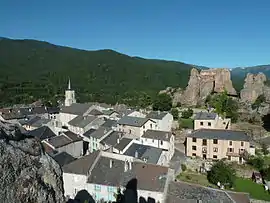Quérigut | |
|---|---|
 A general view of Quérigut | |
Location of Quérigut | |
 Quérigut  Quérigut | |
| Coordinates: 42°42′00″N 2°05′57″E / 42.7°N 2.0992°E | |
| Country | France |
| Region | Occitania |
| Department | Ariège |
| Arrondissement | Foix |
| Canton | Haute-Ariège |
| Government | |
| • Mayor (2020–2026) | Jean-François Bataille[1] |
| Area 1 | 36.4 km2 (14.1 sq mi) |
| Population | 138 |
| • Density | 3.8/km2 (9.8/sq mi) |
| Time zone | UTC+01:00 (CET) |
| • Summer (DST) | UTC+02:00 (CEST) |
| INSEE/Postal code | 09239 /09460 |
| Elevation | 1,022–2,359 m (3,353–7,740 ft) (avg. 1,250 m or 4,100 ft) |
| 1 French Land Register data, which excludes lakes, ponds, glaciers > 1 km2 (0.386 sq mi or 247 acres) and river estuaries. | |
Quérigut (French pronunciation: [keʁigyt]; Occitan: Quergut) is a commune in the Ariège department in southwestern France.
History
Donezan, of which Quérigut is the capital, was a dependency of the crown of Aragon. In 1208, king Pierre II of Aragon ceded the territory to the count of Foix who must pay him homage, in exchange for his neutrality in the succession problems of the Count of Urgel. This sovereignty then passed to the kings of Navarre, through the marriage of Gaston IV, Count of Foix, with Eléonore, heiress to the kingdom of Navarre, which was subsequently united with the kingdom of France by Henry IV, together with the lands of the houses of Foix and Albret.
In June 1944, a maquis resistance was formed in the Quérigut region by Marcel Taillandier, leader of the Secret army in Toulouse. Donezan will also be a fallback place for the Picaussel maquis after its attack in August 1944. Finally, numerous passages will be made to Spain from Quérigut.
Population
Inhabitants are called Quérigutois.
| Year | Pop. | ±% |
|---|---|---|
| 1962 | 197 | — |
| 1968 | 234 | +18.8% |
| 1975 | 171 | −26.9% |
| 1982 | 153 | −10.5% |
| 1990 | 142 | −7.2% |
| 1999 | 116 | −18.3% |
| 2008 | 139 | +19.8% |
See also
References
- ↑ "Répertoire national des élus: les maires" (in French). data.gouv.fr, Plateforme ouverte des données publiques françaises. 13 September 2022.
- ↑ "Populations légales 2021". The National Institute of Statistics and Economic Studies. 28 December 2023.